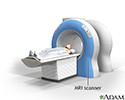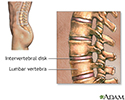Lumbar MRI scan
Magnetic resonance imaging - lumbar spine; MRI - lower backA lumbar magnetic resonance imaging (MRI) scan uses energy from strong magnets to create pictures of the lower part of the spine (lumbar spine).
An MRI does not use radiation (x-rays).
Single MRI images are called slices. The images can be stored on a computer or printed on film. One exam produces many images.
Related exams include:
- Cervical MRI scan (neck MRI)
Cervical MRI scan
A cervical MRI (magnetic resonance imaging) scan uses energy from strong magnets to create pictures of the part of the spine that runs through the ne...
Read Article Now Book Mark Article - MRI
MRI
A magnetic resonance imaging (MRI) scan is an imaging test that uses powerful magnets and radio waves to create pictures of the body. It does not us...
 ImageRead Article Now Book Mark Article
ImageRead Article Now Book Mark Article
How the Test is Performed
You will wear a hospital gown or clothes without metal snaps or zippers (such as sweatpants and a t-shirt). Make sure you take off your watch, jewelry and watches. MRIs can pull on any metallic objects. Some types of metal can cause blurry images.
You will lie on a narrow table that slides into a large tunnel-like tube.
Some exams require a special dye (contrast). Most of the time, you will get the dye through a vein (IV) in your hand or arm before the test. You can also get the dye through an injection. The dye helps the radiologist see certain areas more clearly.
During the MRI, the person who operates the machine will watch you from another room. The test most often lasts 30 to 60 minutes, but may take longer.
How to Prepare for the Test
You may be asked not to eat or drink anything for 4 to 6 hours before the scan.
Tell your health care provider if you are afraid of closed spaces (have claustrophobia). You may be given a medicine to help you feel sleepy and less anxious. Your provider may suggest an "open" MRI, in which the machine is not as close to the body.
Before the test, tell your provider if you have:
- Brain aneurysm clips
- Certain types of artificial heart valves
- Heart defibrillator or pacemaker
- Inner ear (cochlear) implants
- Kidney disease or dialysis (you may not be able to receive contrast)
- Recently placed artificial joints or surgically implanted plates and screws
- Certain types of vascular stents
Stents
A stent is a tiny tube placed into a hollow structure in your body. This structure can be an artery, a vein, or another structure, such as the tube ...
 ImageRead Article Now Book Mark Article
ImageRead Article Now Book Mark Article - Worked with sheet metal in the past (you may need tests to check for metal pieces in your eyes)
Because the MRI contains strong magnets, metal objects are not allowed into the room with the MRI scanner:
- Pens, pocketknives, and eyeglasses may fly across the room.
- Items such as jewelry, watches, credit cards, and hearing aids can be damaged.
- Pins, hairpins, metal zippers, and similar metallic items can distort the images.
- Removable dental work should be taken out just before the scan.
How the Test will Feel
An MRI exam causes no pain. You will need to lie still as too much movement can blur MRI images and cause errors.
The table may be hard or cold, but you can ask for a blanket or pillow. The machine makes loud thumping and humming noises when turned on. You can wear ear plugs to help block out the noise.
An intercom in the room lets you to speak to someone at any time. Some MRIs have televisions and special headphones that you can use to help the time pass.
There is no recovery time, unless you were given a medicine to relax. After an MRI scan, you can return to your normal diet, activity, and medicines.
Why the Test is Performed
The most common reasons for this test are:
- Low back or pelvic pain that does not get better after treatment
- Leg weakness, numbness, or other symptoms that do not improve or get worse
Your provider may also order a lumbar MRI if you have:
- Back pain and fever
- Birth defects of the lower spine
- Injury or trauma to the lower spine
- Low back pain and a history or signs of cancer
- Multiple sclerosis
Multiple sclerosis
Multiple sclerosis (MS) is an autoimmune disease that affects the brain and spinal cord (central nervous system).
 ImageRead Article Now Book Mark Article
ImageRead Article Now Book Mark Article - Problems controlling or emptying your bladder
- Disk herniation
Normal Results
A normal result means your spine and nearby nerves look OK.
What Abnormal Results Mean
Most of the time, abnormal results are due to:
- Herniated or "slipped" disk (lumbar radiculopathy)
Lumbar radiculopathy
A herniated (slipped) disk occurs when all or part of a disk is forced through a weakened part of the disk. This may place pressure on nearby nerves...
 ImageRead Article Now Book Mark Article
ImageRead Article Now Book Mark Article - Narrowing of the spinal column (spinal stenosis)
Spinal stenosis
Spinal stenosis is narrowing of the spinal column that causes pressure on the spinal cord, or narrowing of the openings (called neural foramina) wher...
 ImageRead Article Now Book Mark Article
ImageRead Article Now Book Mark Article - Abnormal wearing on the bones and cartilage in the spine (lumbar spondylosis)
Other abnormal results may be due to:
- Degenerative changes due to age
- Ankylosing spondylitis, a type of arthritis
Ankylosing spondylitis
Ankylosing spondylitis (AS) is a chronic form of arthritis. It mostly affects the bones and joints at the base of the spine where it connects with t...
 ImageRead Article Now Book Mark Article
ImageRead Article Now Book Mark Article - Bone infection
Bone infection
Osteomyelitis is a bone infection. It is caused by bacteria or other germs.
 ImageRead Article Now Book Mark Article
ImageRead Article Now Book Mark Article - Cauda equina syndrome
- Fractures of the lower back due to osteoporosis
Fractures of the lower back
Compression fractures of the back are broken vertebrae. Vertebrae are the bones of the spine.
 ImageRead Article Now Book Mark Article
ImageRead Article Now Book Mark Article - Disk inflammation (diskitis)
Diskitis
Diskitis is swelling (inflammation) and irritation of the space between the bones of the spine (intervertebral disk space).
 ImageRead Article Now Book Mark Article
ImageRead Article Now Book Mark Article - Spinal cord abscess
Spinal cord abscess
Spinal cord abscess is the swelling and irritation (inflammation) and the collection of infected material (pus) and germs in or around the spinal cor...
 ImageRead Article Now Book Mark Article
ImageRead Article Now Book Mark Article - Spinal cord injury
Spinal cord injury
Spinal cord trauma is damage to the spinal cord. It may result from direct injury to the cord itself or indirectly from disease of the nearby bones,...
 ImageRead Article Now Book Mark Article
ImageRead Article Now Book Mark Article - Spinal tumor
Spinal tumor
A spinal tumor is a growth of cells (mass) in or around the spinal cord.
 ImageRead Article Now Book Mark Article
ImageRead Article Now Book Mark Article - Syringomyelia
Talk to your provider about your questions and concerns.
Risks
MRI uses no radiation. There have been no reported side effects from the magnetic fields and radio waves.
It is also safe to have MRI performed during pregnancy. No side effects or complications have been proven.
The most common type of contrast (dye) used is gadolinium. It is very safe. Allergic reactions to this dye are rare. However, gadolinium can be harmful to people with kidney problems that need dialysis. If you have kidney problems, please tell your provider before the test.
The strong magnetic fields created during an MRI can cause heart pacemakers and other implants to not work as well. It can also cause other pieces of metal inside your body to move or shift. For safety reasons, please do not bring anything that contains metal into the scanner room.
References
Chou R, Qaseem A, Owens DK, Shekelle P; Clinical Guidelines Committee of the American College of Physicians. Diagnostic imaging for low back pain: advice for high-value health care from the American College of Physicians. Ann Intern Med. 2011;154(3):181-189. PMID: 21282698 pubmed.ncbi.nlm.nih.gov/21282698/.
Sack KD, Rosner MK. Evaluation and treatment of lumbar disk disease. In: Winn HR, ed. Youmans and Winn Neurological Surgery. 8th ed. Philadelphia, PA: Elsevier; 2023:chap 318.
Gardocki RJ, Park AL. Degenerative disorders of the thoracic and lumbar spine. In: Azar FM, Beaty JH, eds. Campbell's Operative Orthopaedics. 14th ed. Philadelphia, PA: Elsevier; 2021:chap 39.
Samad A, Usmani MF, Khanna AJ. Imaging of the spine. In: Miller MD, Thompson SR, eds. DeLee, Drez, & Miller's Orthopaedic Sports Medicine. 5th ed. Philadelphia, PA: Elsevier; 2020:chap 124.
Van Thielen T, van den Hauwe L, Van Goethem JW, Parizel PM. Current status of imaging of the spine and anatomical features. In: Adam A, Dixon AK, Gillard JH, Schaefer-Prokop CM, eds. Grainger & Allison's Diagnostic Radiology. 7th ed. Philadelphia, PA: Elsevier; 2021:chap 47.
MRI scans - illustration
MRI stands for magnetic resonance imaging. It allows imaging of the interior of the body without using x-rays or other types of ionizing radiation. An MRI scan is capable of showing fine detail of different tissues.
MRI scans
illustration
Lumbar vertebrae - illustration
There are five lumbar vertebrae located in the lower back. These vertebrae receive the most stress and are the weight-bearing portion of the back. The lumbar vertebrae allow movements such as flexion and extension, and some lateral flexion.
Lumbar vertebrae
illustration
MRI scans - illustration
MRI stands for magnetic resonance imaging. It allows imaging of the interior of the body without using x-rays or other types of ionizing radiation. An MRI scan is capable of showing fine detail of different tissues.
MRI scans
illustration
Lumbar vertebrae - illustration
There are five lumbar vertebrae located in the lower back. These vertebrae receive the most stress and are the weight-bearing portion of the back. The lumbar vertebrae allow movements such as flexion and extension, and some lateral flexion.
Lumbar vertebrae
illustration
Review Date: 4/24/2023
Reviewed By: C. Benjamin Ma, MD, Professor, Chief, Sports Medicine and Shoulder Service, UCSF Department of Orthopaedic Surgery, San Francisco, CA. Also reviewed by David C. Dugdale, MD, Medical Director, Brenda Conaway, Editorial Director, and the A.D.A.M. Editorial team.



